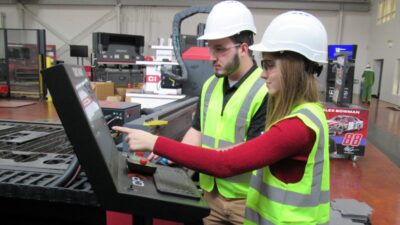Expanded online version of May 2003 Control Engineering‘Back to Basics.’
Click here to read the main article
Not all parts of processing plants or manufacturing facilities are created equal. In fact, some production areas can be downright hazardous. Petrochem plants, underground mines, even grain silos pose the potential of accidental explosion, due to ignitable gases, vapors, or dust that may be present.
Various classification systems have been set up to identify these potentially dangerous industrial environments so that electrical equipment operating in those areas can be regulated to prevent ignition and explosion, thereby ensuring the safety of workers and facilities.
Two main classification systems have emerged, differing in details that reflect their regional origins: A North American system based on the U.S. National Electrical Code (NEC), and a European approach derived from methods developed by the European Committee for Electrotechnical Standardization (CENELEC) and International Electrotechnical Commission (IEC). The latter system is gaining international acceptance, and although incorporated into NEC in 1996, it has received substantially less support in the U.S.
Division or zone In North American practice, class, division, and group labels define the safety level required for equipment installed in hazardous areas of a manufacturing site. Three general classes define the flammable materials present in the atmosphere. Two divisions refer to the hazard probability of these materials—(1) for danger present during normal conditions, and (2) for danger present only under abnormal conditions, as in case of a container rupture or system failure. Seven groups classify the specific offending flammable materials. (See North American classification table for classes and groups.)
North American hazardous area classifications
Class I: Flammable gases and vapors
Group A: Acetylene Group B: Hydrogen, butadieneethylene oxide, propylene oxide Group C: Ethylene, coke ovengas, diethyl ether, dimethyl ether Group D: (Partial list) Propane,acetone, alcohols, ammonia,benzene, butane, gasoline,methane, pentanes, toluene
Class II: Combustible dust
Group E: Metal dust Group F: Coal, coke dust Group G: Grain, plastic dust
Class III: Combustibleflyings and fibers
No group designators defined: Wood flyings, paper fibers, cotton fibers
Source: Control Engineering
With the IEC approach used in Europe (and outside North America), three zones rather than two divisions define the probability of flammable materials being present. Protection type such as flameproof, purging, and intrinsic safety denote the level of safety for the device. Groups carry the same general designation as in the U.S. method, but are differently characterized (see table). For example, the European approach groups requirements for acetylene and hydrogen into the same category, while the traditional North American method separates hazard requirements for these gases.
Comparative group hazard categories
Hazardoussubstances
Europe
North America NEC 505
North AmericaNEC 500-503
Methane
Group I (mines)
Per U.S. Gov. Standards
Class I,Group D
Gases and vapors
Acetylene
Group IIC
Group IIC
Class I,Group A
Hydrogen
Group IIC
Group IIC
Class I,Group B
Ethyl
Group IIB
Group IIB
Class I,Group C
Propane
Group IIA
Group IIA
Class I,Group D
Dusts
Metal
Pending
Class II,Group E
Class II,Group E
Coal
Pending
Class II,Group F
Class II,Group F
Grain
Pending
Class II,Group G
Class II,Group G
Fibers and flyings
Fibers and flyingsWood, paper, orcotton fiber processing
Not classified
Class III
Class III
Source: Control Engineering with data from Bently Nevada.
Plant regions designated Zone 0 or Zone 1 in the IEC system are basically equivalent to Division 1 in the North American classification system, while Zone 2 matches Division 2. Progressing from Zone 2 through Zone 0 indicates an increasing level of risk—see IEC/ATEX classification table. A notable difference between the two methods is that Zone 0 sets apart the region of most probable hazards from Zone 1, which are lumped under one probability in Division 1.
Zone hazard categories, comparisons
Continuous hazard
>1,000 hr/yr
Intermittent hazard
10-1,000 hr/yr
Hazard under abnormal
conditions, &10 hr
Europe:
Zone 0
Zone 1
Zone 2
IEC/CENELEC/NEC505
(Zone 20, dust)
(Zone 21,dust)
(Zone 22, dust)
North America:NEC500-503
Div.1 (gases,dust)
Division 1
Division 2
North America: NEC505
Zone 0
Zone 1
Zone 2
Safety categories-vapors
G1
G2
G3
Safety categories-dust
D1
D2
D3
Source: Control Engineering with data from Bently Nevada .
In either approach, temperate class specifies equipment surface temperature limits that could act as a source of ignition for gases or vapors. The following table defines a classification system for these auto-ignition temperatures. Temperature classes in the European and North American systems are basically identical, however, the IEC method omits subclasses of T2, T3, and T4.
Auto-ignition temperature classes
Temperature classification
Temperature,
Europe North
America
T1
T1
450
(842)
T2
T2
300
(572)
–
T2A
280
(536)
–
T2B
260
(500)
–
T2C
230
(446)
–
T2D
215
(419)
T3
T3
200
(392)
–
T3A
180
(356)
–
T3B
165
(329)
–
T3C
160
(320)
T4
T4
135
(275)
–
T4A
120
(248)
T5
T5
100
(212)
T6
T6
85
(185)
Source: Control Engineering with data from SOR Inc., and Emerson Process Management.
ATEX Directive is next A related development affecting hazardous areas is the growth of “CE marking” directives issued by the European Union (EU). The so-called ATEX Directive (French for “Atmospheres Explosible”) becomes mandatory on July 1, 2003, after operating on a voluntary basis since March 1996. The ATEX Directive will regulate applicability of equipment for use in the three zones. It adds specific time duration to the presence of hazards and a prefix “2” to indicate dust hazard. (See “Zone hazard categories, comparisons” table.)
The directive applies to all EU member states and to importation of products to the EU. Several other European countries also have adopted the directive. New certification will be needed for products shipped to the affected countries.
Will division and zone coalesce? Several potential benefits are seen in efforts to produce a single hazardous area classification standard usable worldwide. Among them are reduced costs due to shorter, simpler certification procedures and lower product development costs.
However, chances are low that the two classification systems will come together into one uniform standard in the near future. An April 2003 study by Venture Development Corp. (VDC, Natick, MA), entitled “European and North American Markets for Intrinsically Safe Equipment,” verifies this notion. Results of the study indicate that very few North American users are shifting to apply IEC or zone hazardous area classifications when implementing intrinsically safe protection methods—or are intending to so through 2006. For survey numbers, see CE, June 2002, p 9, or May 14 Daily News .
Reluctance to adopt a single hazardous area classification standard ranges from protective business concerns of the manufacturers to lack of understanding of benefits by users and the perceived added cost of making the conversion, says VDC’s study.



